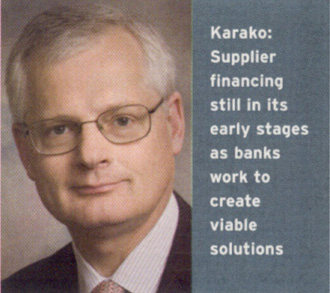At the Sibos international banking conference in Atlanta in 2004, David Taggart, the treasurer of one of the world’s most recognizable brand names, Coca-Cola, made a direct plea to the banks to deliver greater efficiencies to corporates’ supply chains.
 |
He underlined the challenge for corporates in integrating their logistical supply chain with the financial supply chain and called on the banks to extend the same levels of efficiency to corporates that they had achieved by automating interbank communication using the Swift network. “I firmly believe that if you look forward over the next 10, 20 years, that you have a similar opportunity in front of you to accomplish what you’ve accomplished on the financial supply chain by bringing that same sort of efficiency, that same sort of methodical progress to the logistical physical product supply chain,” he proclaimed.
Taggart’s speech marked the opening of a new chapter in banks’ participation in the corporate supply chain. Historically, banks were restricted to guaranteeing and settling the payment leg of a transaction between a buyer and supplier. While the financial supply chain comprises relationships between corporates, their banks and other financial intermediaries, the logistical supply chain Taggart referred to is a complex web of relationships involving geographically dispersed suppliers of different sizes and financial standing, and a multitude of intermediaries, including customs and shipping organizations. It is this web of relationships in the logistical supply chain that financial service providers are focusing on, giving rise to the term supply chain financing (SCF).
Why are banks suddenly so interested in corporates’ supply chains? After all, supply chains are as old as trade itself, and for hundreds of years banks were satisfied with providing letters of credit, which facilitated the reduction of credit risk and guaranteed the supplier would get paid for goods sold. Global trading relationships have become more complex, though, and the opening up of markets such as China and India and the proliferation of e-procurement have made it easier for buyers to source goods from suppliers far afield. The banks have been left behind as more companies resort to open-account trading, which does not require a costly and cumbersome letter of guarantee from a bank.
Open for Business
 “Approximately 80% of global trade is now done on an open-account basis,” remarks Arthur Vonchek, CEO of Bolero, which provides an electronic, paperless trading platform linking the physical and financial supply chains. “There is a great open void that banks are not playing in, so they feel they need a solution for it.” The “catch 22” for banks, he points out, is that in order to provide supply chain financing, they need to participate in customers’ supply chains. “With the letter of credit business, that happened automatically, but that business is diminishing now, and banks are not involved so much,” he says.
“Approximately 80% of global trade is now done on an open-account basis,” remarks Arthur Vonchek, CEO of Bolero, which provides an electronic, paperless trading platform linking the physical and financial supply chains. “There is a great open void that banks are not playing in, so they feel they need a solution for it.” The “catch 22” for banks, he points out, is that in order to provide supply chain financing, they need to participate in customers’ supply chains. “With the letter of credit business, that happened automatically, but that business is diminishing now, and banks are not involved so much,” he says.
Part of the challenge for banks is that they don’t yet agree on what they mean by “supply chain.””I don’t think there is a single definition yet for supply chain,” remarks Keith Karako, managing director and global trade finance head at Citi. “It encompasses not only trade but also cash management, and we are trying to come up with a holistic solution for clients.”
The SCF market is somewhat fragmented, with solutions addressing different parts of the supply chain. A number of banks are focused on the accounts payable side, others on the accounts receivables side, and some are even trying to break into the logistics side of the physical supply chain in order to capture information further upstream, which has an impact on working capital downstream.
There are concerns, however, that newer entrants are merely jumping on the SCF bandwagon instead of developing solutions that corporates really want. According to Vonchek, some banks are designing SCF solutions without consulting their corporate customers. “Swift’s Trade Services Utility is a good example of that,” he says. “It started out as bank collaboration largely around the open-account issue. The result is a potentially powerful utility but not a solution, and while it standardizes data pertaining to the purchase order and invoice between banks, it does not offer anything directly to corporates.”
The challenge for any firm hoping to become a serious provider in the SCF space is that there is no all-encompassing solution that suits every industry or corporate supply chain. “While there are commonalities, every industry sector is different, and every supply chain is different in terms of the participants, products, jurisdictions and business models used,” asserts Sarah Jones, CEO of SCF Capital, a company specializing in the structuring of industry procurement and working-capital financing programs for large global corporates and their multitiered suppliers and distributors. “Success means having good industry sector and corporate business knowledge,” she says.
Working with Customers
The banks are quick to assert that the SCF solutions they are building are developed in close collaboration with their customers. Lionel Taylor, head of trade and supply chain at Royal Bank of Scotland (RBS), says RBSs customers were involved in recent enhancements to its previously manual supplier-financing solution. “The idea of doing something manually was to make sure that when we developed an online version, it was exactly what customers needed,” he says.
By launching later, Taylor says it enabled the bank to gain a better understanding of the drivers within the buyer organization, including catering for their balance sheet requirements. Taylor also believes its relationship with Bank of China (BOC) gives it an advantage over other SCF providers. “We have the advantage of 11,000 branches of Bank of China across the country,” he says. “BOC understands local market conditions and has a presence in the towns where Chinese companies are based.”
Nordic bank SEB, which has provided supply chain financing for the past four years, says it has operations with several large international corporates and suppliers in many different countries. “The volumes are substantial,” the bank says, “and we are confident that our business will expand even more during 2008.”
Despite the different array of SCF solutions on offer, most of the activity to date has been focused on the payables side. “When people think of supply chain financing, typically they are talking about supplier financing and reverse factoring, which leverages the credit standing of the buyer to extend payables for the buyer and to help the supplier get paid more quickly,” says Jones of SCF Capital.
As Karako of Citi explains, typically in supplier financing the buyer has a better credit rating than the supplier, and they want to see if they can leverage their rating to extend DPO (days payable outstanding). Under supplier financing, the bank extends early payment to the supplier net of any discounting charges agreed based on instruction from the buyer to settle invoices on maturity. Supplier financing is considered to be less risky than conventional factoring because the bank knows the buyer will settle the invoices. The benefit for suppliers is that they get paid earlier and can attract more cost-effective financing, which is off balance sheet, while the buyer increases its cash flow without severely affecting existing supplier relationships.
Funding Costs Grow
 Abbey UK Corporate Banking says supplier or reverse factoring financing solutions are becoming increasingly relevant as DPO are being pushed further out by buyers. The bank points to studies that indicate DPO in European payments is now 59.2 days on average, and payment delays have risen to 16.8 days, equating to euro250 billion in delayed accounts receivable. These delays are putting pressure on small and mediumsize suppliers, which typically pay a much higher cost of funding.
Abbey UK Corporate Banking says supplier or reverse factoring financing solutions are becoming increasingly relevant as DPO are being pushed further out by buyers. The bank points to studies that indicate DPO in European payments is now 59.2 days on average, and payment delays have risen to 16.8 days, equating to euro250 billion in delayed accounts receivable. These delays are putting pressure on small and mediumsize suppliers, which typically pay a much higher cost of funding.
With credit becoming less readily available, companies recognize that squeezing their suppliers can be to their own detriment. “Procurement departments have been focused on reducing the number of suppliers and negotiating volume discounts,” says Jones. “But a reduced number of suppliers means an increased reliance. What happens if one of those suppliers goes out of business? Large companies are beginning to realize that suppliers and other partners such as contract manufacturers are vital to the ongoing success of their business and that decisions made in silos by one particular function may not be optimizing the end-to-end financial supply chain.”
In order for supplier or vendor financing solutions to work effectively, banks need to work closely with large volume buyers in order to gain access to their network of suppliers. “SCF is not a success until the suppliers join in,” asserts SEB. In addition to having a “well oiled machine” for signing up suppliers, Karako of Citi says that success in the vendor financing space is contingent on banks understanding local and regulatory complexities. “When you go into emerging markets, the complexity increases,” he says. “In China there are limitations on buying hard currency receivables outside of the country, as well as withholding tax issues.”
Andrew Betts, global head of supply chain financing, ABN AMRO Transaction Banking, says that supplier financing requires local presence and market knowledge. “In order to finance buyers and suppliers across a supply chain covering multiple countries, you need to have a structured solution in different parts of the world,” he says.
But not all buyers may to want to leverage their credit to pay a supplier earlier, particularly if they do not have the credit lines to support approved invoices worth $100 million, for example. Karako maintains that supplier financing is becoming commoditized, as there are several bank-owned and independent platforms today.
The Dream Scenario
 The current focus for most banks is on attaining the “Holy Grail”: pre-shipment or inventory financing.”Financing the supplier much earlier in the transaction will become much more prominent,” says Betts of ABN AMRO. But pre-shipment financing is particularly challenging, he adds, as the bank is financing suppliers earlier in the process, before the invoice has been approved by the buyer. “Pre-shipment financing requires a much deeper understanding of the business occurring between the buyer and supplier,” he explains. “You also need to be present in the supplier’s home market. It is about understanding the different parts and structuring a solution that provides value in working capital enhancement.”
The current focus for most banks is on attaining the “Holy Grail”: pre-shipment or inventory financing.”Financing the supplier much earlier in the transaction will become much more prominent,” says Betts of ABN AMRO. But pre-shipment financing is particularly challenging, he adds, as the bank is financing suppliers earlier in the process, before the invoice has been approved by the buyer. “Pre-shipment financing requires a much deeper understanding of the business occurring between the buyer and supplier,” he explains. “You also need to be present in the supplier’s home market. It is about understanding the different parts and structuring a solution that provides value in working capital enhancement.”
Jones says that the volume of accounts receivable (AR) assets that are financed globally is minimal. “This is a huge missed opportunity to better leverage what, for platform companies, represents one of the largest balance sheet assets, especially if the receivables are enhanced via credit insurance and business risk,” she says. Once AR assets are packaged in a standardized way, Jones highlights the opportunity for an “AR exchange” featuring multiple financiers, as she maintains that single bank institutions do not have the credit risk capacity to service the needs of the largest corporates. “Therefore, why not enable an exchange and achieve more efficient pricing and accessibility for alternative investors who have the credit appetite and liquidity?”
There is no question that to be successful in SCF requires ongoing investment in technology, and the larger global trading banks believe they are better positioned than regional providers, which may need to outsource their supply chain financing or trade services business to other banks or white-label solutions. SCF is still a nascent business, and few banks can comfortably claim they have arrived at the winning formula.”If there is a winning formula, we don’t know it yet,” says Karako.”We hope we will be successful in the long term, but we are still in the early stages.”
Anita Hawser



